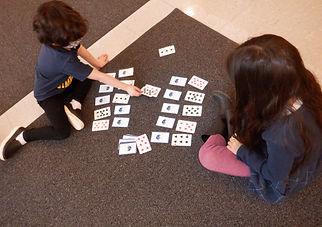Benefits of Play-Based Learning
Play, in the simplest term, is when children are freely taking part in an activity of their choice for pure enjoyment, that is gratifying and actively engaging, and is focused more so on the means than the ends (Pyle and Danniels, 2017). As an early childhood educator, play is critical in ensuring our students are happy, engaged, motivated, and excited for the possibilities within their learning experiences. Behavioral research illustrates an association among children’s play and the development of several areas such as language, mathematics and spatial skills, scientific thinking, executive functions, and social and emotional development (Hassinger-Das et al., 2017). Within play, children are able to develop vital skills such as empathy, self-regulation, turn-taking, and cooperation as they develop and adapt their social and emotional capabilities (Pyle et al., 2018). As children are actively participating and interacting within their play environments, they are practicing and developing their advanced thinking skills such problem-solving skills, and convergent and divergent thinking abilities. They are also forming the foundation for future growth in all of the five developmental domains: physical, language, social, emotional, and cognitive (Pyle et al., 2018).
Furthermore, a research field titled the science of learning has recognized four crucial components that make learning successful:
-
Learning happens best when the children are psychologically and emotionally active.
-
Learning happens best when they are engaged and not distracted.
-
Learning happens best when they are building meaningful connections to their lives.
-
Learning happens best when they are socially interactive with their peers and adults
(Hassinger-Das et al., 2017).



Within my own kindergarten classroom, play, which takes on many forms, is a vital component of my classroom culture. Of course, there are standards, specific content and skills my students need to master before they move on to later grades. Therefore, having a balance of play-based learning with opportunities for explicit and direct instruction, supports my students in their early years of education in the most developmentally appropriate ways. Students at this age need to move around and need to be able to manipulate and explore materials on their own so they can develop their own meaning and form a connection to the content and materials. My students are learning through play and hands-on experiences that give way to the development of emotional and social skills, facilitates problem solving and perspective taking as well as the development of a theory of mind (Ashiabi, 2007).

When introducing a new concept, for example base ten frames to facilitate the foundation for place value and the development of important math skills and concepts, I first like to incorporate these materials throughout the classroom environment for my students to explore and manipulate on their own. Through play, students can begin to explore and internalize the academic concepts and the teacher will have a chance to further their learning (Pyle and Danniels, 2017). For instance, the ten frames will be available at the investigation center with additional materials to work with such as acorns or unifix cubes, as well as being made available in our outdoor classroom and during morning centers. This provides them the opportunity to investigate and play with the new “tool.” The teacher will observe how the students are interacting with the new material and intervene and make suggestions as they see fit. It is always a good idea to have your students explore and investigate new materials or new academic “tools” prior to having a lesson or activity with them. This will give the students a chance to have fun with the new item as well as a way to get them more comfortable with it before using it in a specific way. Plus, if anyone has been in a kindergarten class when the teacher gives students brand new manipulatives or materials to use, the students are distracted from the actual lesson because they are so interested in what this new item is. Give them time to explore new materials on their own!


There was one year when I first incorporated these ten frames into our classroom, prior to having an explicit lesson on them. One child took the frame and used it to count the rocks and acorns they found outside without a teacher’s prompt. This example of discovering meaning of the materials on their own is a powerful example of how important the different forms of “play” are for early childhood classrooms. Following this introduction, I will then incorporate direct and explicit instruction on the uses of these materials within a small group setting. Next, students will have ample time to explore and travel to different centers around the room that are reinforcing their number sense through different ten frame activities.
During this time, I like to define it as playful learning or learning through games, where my students are engaged in different types of games and learning experiences to strengthen their knowledge on this topic. My students do not realize they are being taught something and or practicing a skill however they are learning and not just playing. Some examples of games I would have out would be the card game Garbage or Trash, roll and count game with a peer, ten frame war, ten frame memory, building ten frames using Legos and/or craft sticks, and egg carton and uno ten frame game.
References:
Ashiabi, G.S. (2007). Play in the preschool classroom: Its socioemotional significance and the teacher’s role in play. Early Childhood Education Journal, 35(2), 199-207. https://doi.org/10.1007/s10643-007-0165-8
Danniels E, Pyle A. Defining Play-based Learning. In: Tremblay RE, Boivin M, Peters RDeV, eds. Pyle A, topic ed. Encyclopedia on Early Childhood Development [online]. https://www.child-encyclopedia.com/play-based-learning/according-experts/defining-play-based-learning. Published: February 2018. Accessed 28 December 2021.
Pyle, A. & Danniels, E. (2017). A continuum of play-based learning: The role of the teacher in play-based pedagogy and the fear of hijacking play. Early Education and Development, 28(3), 274-289. https://dx.doi.org/10.1080/10409289.2016.1220771
Pyle, A., Prioletta, J., & Poliszczuk, D. (2018). The play-literacy interface in full-day kindergarten classrooms. Early Childhood Education Journal, 46(1), 117-127. https://doi.org/10.1007/s10643-017-0852-z
